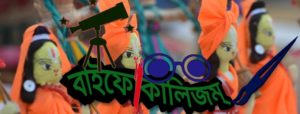প্রাচীন বাংলার ঐতিহাসিক সময়কাল
(The Historic period of Ancient Bengal)
ছবিঃ গৌতম মাহাতো
লিখছেন-দুর্গাশঙ্কর দীর্ঘাঙ্গী
(২১)
” The literary references in the Vedic, Epic and Sutra text, both Brahamanical and non-Brahamanical, do not admit of a definite chronological arrangement.
For a chronological treatment of the subject it is necessary to turn the evidence of literature, Indian and foreign, assign able to well-known epochal, and that of the early
epigraphs. “
যা কিছূ লিখিত উল্লেখ আছে আমাদের বেদ, মহাকাব্য, সূত্র লিপি, ব্রাহ্মণ সম্বন্ধীয় এবং অব্রাহ্মণ সম্বন্ধীয়, তা কোন নির্দিষ্ট কালানুক্রমিক
ব্যবস্থা নয়। আর যদি কালানুক্রমিক ভাবে সাজাতে হয় তাহ’লে প্রামাণ্য হিসেবে সাহিত্য সে ভারতীয় বা বৈদেশিক হস্তান্তর যোগ্য তথ্য, সবিস্তারে যুগ, পুরা লিপি এইসবের উপর নির্ভর করতে হবে।
“According to the evidence of Pliny, Ptolemy, and many other classical writers, the people in question occupied the country of the lower Ganges and its distributeries. Jaina and Buddhist legends
Connect the names of the great Mauryas
and their contemporaries with Pundravardhana, and Chinese pilgrims found Asokan monuments in various parts of the province. The existence of
Pundranagara in the Maurya epoch is, in the opinion of some scholars, proved by
an old Brahmi inscription, (Barua, IHQ.
1934,pp.57ff; D. R. Bhandarkar, El
XXI. 83ff; P. C. Sen, IHQ, 1933,pp.722 ff. )
unearthed at Mahasthangarh in ttheBogra
district. “
খৃষ্টীয় প্রথম শতাব্দীতে প্লীনী লিখেছেন যে, জাহাজ সকল গোদাবরীর নিকট দিয়া কেপ -পালি
-মোরাস যেত এবং ঐ স্থান হতে ফলভার আর পার
টেনিনগেল ও তথা হ’তে ত্রিবেণী দিয়া পাটনায়
যেত।
মৌর্য্য সাম্রাজ্যের সভ্যতা এই স্থানে বিদ্যমান না থাকলেও, তাহার প্রভাব এই স্থানে বিস্তৃত হয়েছিল তা সুনিশ্চিত। এই সময় ব্রাহ্মণ ক্ষত্রিয়দের সঙ্গে
বহু বৌদ্ধ ও জৈন এই স্থানে এসে বসবাস করতে শুরু করেন।
এর কয়েক শতাব্দীর পর খৃষ্টীয় চতুর্থ শতাব্দীতে
বিজয়ী সমুদ্রগুপ্তের আমলে সমগ্র বঙ্গদেশ গুপ্ত
সাম্রাজ্যভুক্ত হয়েছিল। দিল্লি নগরীর লৌহ স্তম্ভের
উপর খোদিত লিপিতে অঙ্কিত আছে যে, বঙ্গদেশে যুদ্ধ করতে যেয়ে সম্মিলিত শত্রুগণকে তিনি বিপর্যস্ত ও পরাভূত করেছিলেন।
মহাকবি কালিদাস ৪৮০ হতে ৪৯০ খৃষ্টাব্দের মধ্যে
‘রঘুবংশ ‘রচনা করেন, তিনি রঘুর দিগ্বিজয় কাহিনীতে সুহ্ম দেশের কথা উল্লেখ করেছিলেন।
বিজয়ী রঘু এইরূপে ক্রমে ক্রমে সকল দেশ জয়
করিতে করিতে পরিশেষে পূর্ব্ব মহাসাগরের তালবন দ্বারা শ্যামবর্ণ উপকন্ঠে উপস্থিত হলেন।
নদীবেগ যেরূপ উচ্ছৃত বৃক্ষ সকল উন্মুলিত করে,
রঘুর স্বভাবও সেইরূপ জানিতে পারিয়া সুহ্মদেশীয় নৃপতিগণ বিনীত ভাব অবলম্বন পূর্বক
আত্মরক্ষা করলেন।
২২
খ্রীষ্ট জন্মের পরের শতাব্দীগুলিতে প্রাচীন বাংলার
ভৌগোলিক বিবরণ ও সে সময়ের ঘটনাগুলির
সম্বন্ধে ধারণা পাওয়া যায় কতকগুলি তথ্যসূত্র ধরে যেমন ১) লোহিত সমুদ্রের পেরিপ্লাস (the periplus of the erythraean sea) ২) টলেমির ভূগোল ( the Geography of Ptolemy) ৩)
মিলিন্দা -পানির(the Milinda-Panho)
৪) নাগার্জুনকোন্ডা শিলালিপি (the Nagarjunikonda inscription) , during 2nd centuries, this hill was famous for Buddhist activity, The university, monasteries, attracting students from China, Gandhara,
Bengal and Sri Lanka.)
“The periplus, describing the east coast of India, mentions the river Ganges and a market -town on its bank which had the same as the river. The city of Gange is also mentioned by Ptolemy who describes it as a metropolis ( মহানগরী) and distinguishes it from Tamtalites i. e. Tamralipti. Of special interest is Ptolemy’s
reference to the five mouths of Ganges (গঙ্গা নদীর পাঁচটি মুখ) : namely, the Kambyson mouth, the most western;the second mouth, called Mega, ;the third called Kamberikhon(কাম্ববীখন) ; the fourth styled Pseudostomon(মৃত নদীর মুখ) ;and the fifth mouth, Antibole (পূর্ব দিকের নদীর মুখ) Opinion differs in regards to the identification of these distrbutaries. In the
Opinion of the present writer, Kambyson stands for Sanskrit Kapisa mentioned in Kalidasa. This answers to the modern Kasai (কাঁসাই) which flows past Midnapur and, like the Rupnarayana, may have been
erroneously (ভ্রান্ত ভাবে) branch of Ganges.
The mega had been identified with the Hooghly. The Kamberikhon is said to represent the Kobbadak or Kabadak
(Kapotaksha), the “Cobbaduck” of
Rennell’s map, which flows past Jhinkargachha. A more plausible identification would be with the Kumara(Kumaraka) river which issues out of the Matabhanga branch of the Padma and joining the Torah, ultimately empties
itself into the Haringhata estuary and the
Arialkhan. The Pseudostomon, “false mouth” is probably so called as it lay concealed behind numerous islands. It is
to correspond to the estuary of the Padma, and the Meghan. The antibole (lit.”thrown- back”is regarded by some as identical with the old Ganga that flow past Dacca. The precise identification must await future research. “
গুপ্ত সাম্রাজ্য ধ্বংসের পর সুহ্মদেশ কিছুকালের জন্য স্বাধীনতা লাভ করিয়াছিল। খৃষ্টীয় সপ্তম শতাব্দীতে রচিত ‘দশকুমারচরিত’ লিখিত আছে
যে, সুহ্ম দেশ সেই সময়ে সমুদ্রোপকূল পর্যন্ত বিস্তৃত ছিল।
References: The History of Bengal- 1943
Dr. (Prof.) R. C. Majumdar
হুগলি জেলার ইতিহাস- ১৯৪৮
সুধীরকুমার মিত্র বিদ্যাবিনোদ।
ক্রমশঃ….



























